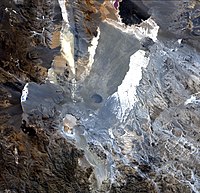
Photo from wikipedia
Abstract Land subsidence has played and is still playing a significant role in coastal wetlands worldwide and in palaeogeographical reconstructions of such wetlands. The varying thickness of compaction-prone sediments over… Click to show full abstract
Abstract Land subsidence has played and is still playing a significant role in coastal wetlands worldwide and in palaeogeographical reconstructions of such wetlands. The varying thickness of compaction-prone sediments over a stable subsurface is a key factor in determining its magnitude and in locating the most affected areas. In the coastal low-lying Agro Pontino (Lazio, Italy), subsidence of the past 90 years has been mapped using historical elevation data. Due to the fortunate preservation of distal Avellino tephra (AV-tephra, ca. 1900 cal. BCE) within its marshy strata, discovered a decade ago, detailed palaeogeographical reconstruction of the landscape in preparation for an assessment of its land use suitability in the Early Bronze Age (EBA) was possible. Current altitude variations of water-lain tephra in lake areas assumed to be connected necessitated a closer look at its original deposition altitude and the role of post-depositional subsidence. Recent subsidence patterns proved very useful for distinguishing stable from subsidence-prone areas. Two different EBA palaeo lake environments are distinguished: an inland and a near-coastal lake. The AV-tephra altitude variation within these lakes partly marks differential post-depositional subsidence within these lakes. Calculation of initial ripening of tephra-bearing lake deposits on top of shallowly buried Pleistocene ridges allowed for an estimation of original tephra deposition altitudes and associated lake levels. For the inland lake, a wide lake edge zone between 0.5 and 2 m above current sea level (m asl) was reconstructed, where EBA habitation or land use was possible. At the near-coastal lake, a water level of −1.5 to −1.3 m asl at the time of AV-tephra deposition was constrained. Because tephra deposition occurred here just after marine influence ceased, this altitude range is proposed to be a Relative Sea Level (RSL) index point at the time of AV-tephra deposition. The altitude range is in agreement with RSL models for tectonically stable areas in this region. The importance of subsidence in palaeogeographical, water level and RSL reconstructions in the region is stressed.
Journal Title: Catena
Year Published: 2020
Link to full text (if available)
Share on Social Media: Sign Up to like & get
recommendations!